
Haizhu Bridge was the first bridge across the Pearl River in Guangzhou. It was originally built in 1933 as a three-hole through steel truss bridge with simple support and was part of the central axis in Guangzhou at that time. On the eve of the liberation of Guangzhou in 1949, the Kuomintang army blew up the original bridge. Haizhu Bridge was repaired from the open type to a fixed type in October 1950, and then it was repaired in 1974, 1995, and 2012 again. In 1995, a self-anchored sling scheme was adopted to transfer the dead load of the middle hole to the sling. Haizhu Bridge thus became a three-hole continuous self-anchored suspension bridge, as what it is today.
Haizhu Bridge was opened to traffic after an 18-month overhaul On September 1, 2013. The Philatelic Society of Haizhu District in Guangzhou printed and issued 2,000 "Commemorative Envelope for Opening of Haizhu Bridge Guangzhou After Overhaul" to celebrate this great event. On a posted commemorative cover collected in Steel Structure Museum, there was rich information like cachet, posted postmark, and postage machine mark, in addition to a printed photo of the real Haizhu Bridge and "Opening of Haizhu Bridge Guangzhou After Overhaul in August 2013" in Chinese characters.
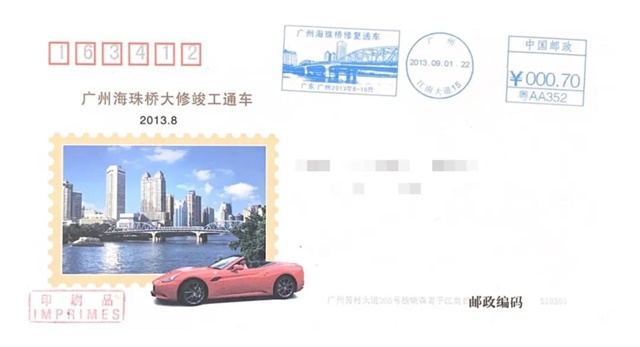
Commemorative Envelope for Opening of Haizhu Bridge Guangzhou After Overhaul
Construction of Haizhu Bridge
The idea of building a bridge on the Pearl River to connect the north and south banks of Guangzhou had long been conceived. As early as the reign of Emperor Guangxu in the Qing Dynasty (1875-1908), there was a proposal to build a bridge over the Haizhu Rock. In 1920, the Guangzhou authorities again proposed to build a bridge. However, the proposal ended up in nothing due to the turbulent political situation at that time. In 1929, the local government headed by Chen Jitang proposed the bridge construction plan for the third time and put it into practice.
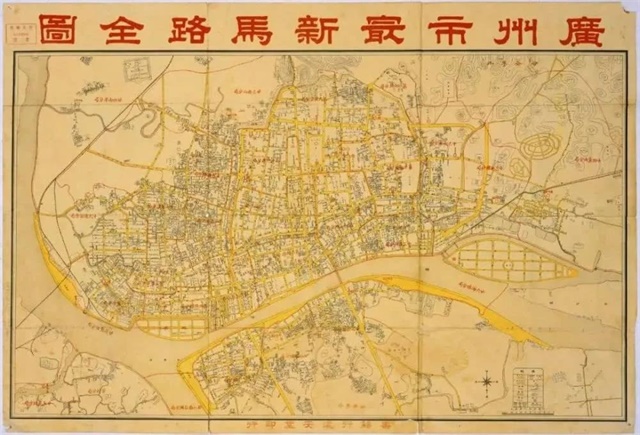
Street map of Guangzhou in the 1930s
Chen Jitang (1890-1954), alias Bonan,was born in Fangcheng, Guangdong (now Fangchenggang, Guangxi). As one of the representatives of the Guangdong warlord, he governed Guangdong from 1929 to 1936, making many achievements in economy, culture and municipal construction. The "Three-Year Economic Construction Plan" developed under his leadership covered many fields such as agriculture and forestry, animal husbandry, aquaculture, mining, metallurgy, chemical industry, textiles, and transportation. Haizhu Bridge was one of the construction achievements.
Haizhu Bridge was constructed under the leadership of Guangzhou Design Committee. Shenchang Firm from the U.S. became the successful bidder with a price of RMB 1.032 million, and the project was subcontracted by the US Markton Company. The bridge was located on the central axis of the urban area of Guangzhou to meet the traffic needs on both sides of the strait as much as possible. Because the red hard clay at the bottom of the Pearl River could bear the weight of the bridge, the project went on smoothly. The bridge was originally called the "Great Iron Bridge over the Pearl River" and was later renamed as "Haizhu Bridge" due to its proximity to Haizhu Rock.

Haizhu Bridge built by Markton Company
Originally, Haizhu Bridge was 435 meters long. The main bridge was 183 meters long; the bridge center was about 8 meters high; the bridge deck was 18 meters wide; the middle roadway was 12 meters; sidewalks protruded the steel truss on both sides for 3 meters. Four bridge piers were evenly arranged under the bridge, dividing the space into three holes. The southern and northern holes were 48.7 meters wide, and the middle hole was 67 meters wide. The two bridge piers in the middle hole were equipped with electric locks that could pull up the middle section of the bridge separately to open the upper section for the passage of large ships. Besides, in order to reduce the weight of the bridge while open and closed, the deck was paved with wooden blocks and then asphalt, and a hut was built next to the bridge to ensure that the bridge could be opened at any time.
On February 15, 1933, as one of the celebrations for the 12th anniversary of the Guangzhou Municipal Government, the opening ceremony of Haizhu Bridge was a big event. More than a hundred thousand spectators gathered on both sides of the Pearl River for a lively affair. At 1:00 pm, Liu Jiwen, then the mayor of Guangzhou, delivered a speech, announcing the opening of the bridge, and unveiled the plague that read "Haizhu Bridge" inscribed by Hu Hanmin, a Kuomintang veteran. According to the Guide to Guangzhou in the 23rd year of the Republic of China, this inscription had "every character sized ten feet, that is, the two-character name was sized more than three feet."
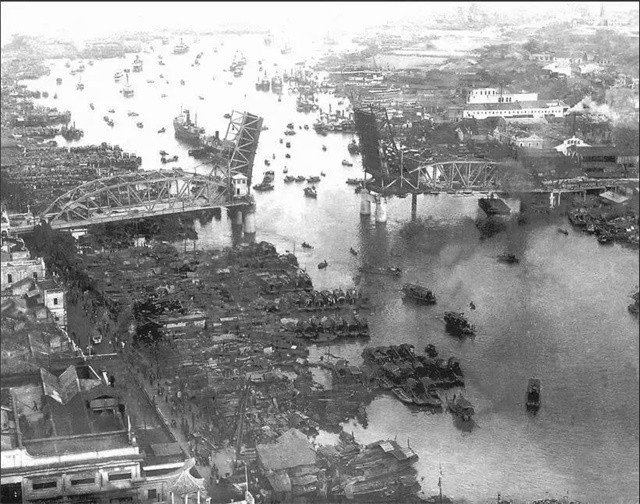
Opening of Haizhu Bridge
After Haizhu Bridge was completed, it was opened four times a day, and it took only 5 minutes to open or close it each time. Ships could pass for free within the specified time. Private ships were charged RMB 10 for passing the bridge beyond the specified time. In addition, there were specific and detailed regulations on management and maintenance of the bridge.
A War-ridden Bridge
When completed, Haizhu Bridge greatly facilitated the mobility of Guangzhou citizens and inspired Chinese people to "strengthen the nation and save the country". However, China was thrown amid the flames of war soon, and Haizhu Bridge was a witness of this history.
After the Anti-Japanese War broke out in full swing, from August 1937 to October 1938, the Japanese army bombed Guangzhou for 14 months. Tianhe Airport, the northern and southern feet of the Haizhu Bridge, and the military and political organs in the city center were the hardest targets of enemy planes. As one of the most attacked target, the opening and closing device in the middle hole of Haizhu Bridge was damaged. In October 1938, after occupying Guangzhou, the Japanese army stole and shipped the entire equipment back to Japan. Thus, Haizhu Bridge was deprived of the five-year opening and closing service, and ships could only pass under the clearance of the bridge.
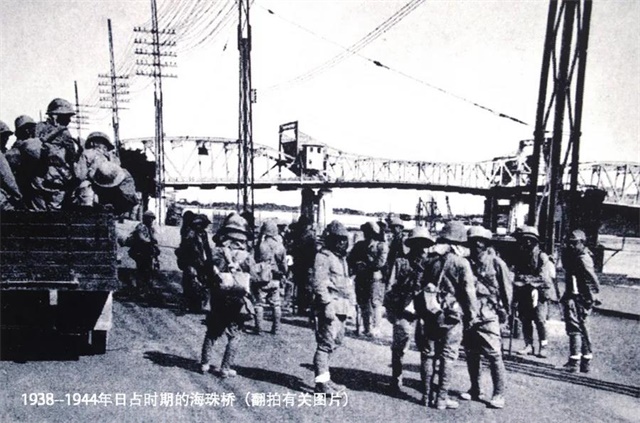
The Japanese invaders set up a warning line at Haizhu Bridge in 1938
Haizhu Bridge also witnessed the defeat and withdrawal of the Japanese invaders. On September 16, 1945, the Japanese military representative signed an instrument of surrender at the Sun Yatsen Memorial Hall. According to the Guangzhou Daily the next day, after the signing ceremony, "The defeated representatives were taken by the Chinese army by three cars driving southward to the concentration camp via Haizhu Bridge."
Before leaving Guangzhou, the Kuomintang army called for "general retreat, general strike, and general destruction", shot political prisoners, and damaged traffic facilities on October 14, 1949. Haizhu Bridge was blown up at 17:50 that day. According to reports, "The explosion was heard three times in a moment and startled the whole urban area", causing great casualties and property losses. Haizhu Bridge was completely destroyed and closed for traffic. The middle section of the bridge deck sank into the river, with only two piers standing above the river. The casualty data on the third day after the explosion showed that "More than 200 citizens were killed or injured, more than 300 houses collapsed, two vehicles were turned over, and more than three shipwrecks occurred." The news that the bridge was bombed irritated the citizens of Guangzhou badly.
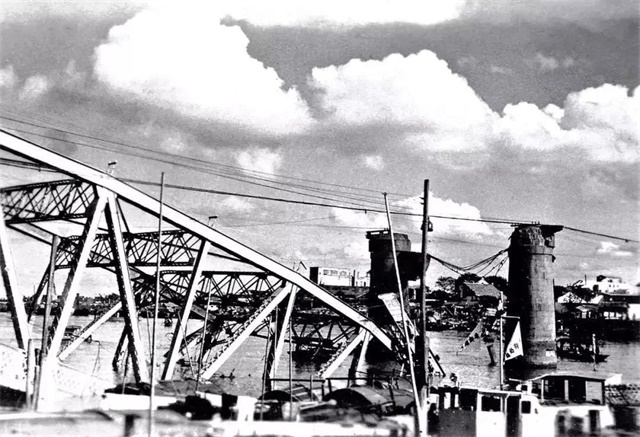
The Kuomintang army destroyed Haizhu Bridge during a retreat in 1949
Previous restorations and expansions
Just after Guangzhou's liberation, the city was economically underdeveloped but faced with daunting takeover and construction tasks. After the Guangdong-Wuchang Railway was repaired and opened to traffic in November 1949, the municipal government resolutely put the repair of Haizhu Bridge on the agenda. From March 1950, it was repaired by Guangdong Public Construction Engineering Company, and it took six months for the company to repair the four bridge piers.
The main difficulty at the time came from the lack of steel that was needed to repair the bridge. It was both difficult to salvage the original steel from the river and to import steel from Hong Kong, Fortunately, the steel supply was guaranteed through technical research and secret procurement from Hong Kong. By November 1950, the repair of Haizhu Bridge was officially done.
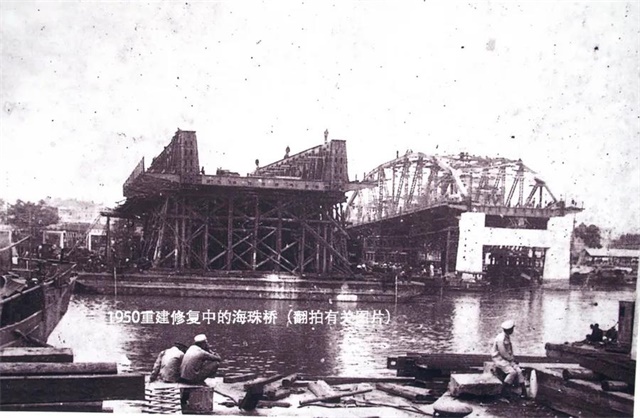
Haizhu Bridge under reconstruction and restoration in 1950
Since its restoration in the 1950s, Haizhu Bridge has also undergone three large-scale overhaul projects.
In 1974, in order to alleviate traffic congestion on the bridge, the relevant department expanded Haizhu Bridge by increasing the width from 18m to 33m, adding two 8m bicycle lanes on both sides of the original roadway on the bridge deck, and retaining the 3m protruding sidewalks.

Citizens passing Haizhu Bridge in the 1980s
In the 1990s, Haizhu Bridge was seriously aging, with the middle-hole deck sinking, the bridge structure partially deformed, and rust everywhere. In 1995, Haizhu Bridge underwent the second overhaul. In addition to large-scale de-rusting, a self-anchored sling scheme was adopted. Suspension sling was used to share the pressure on the middle-hole beam frame. The load on the bridge was increased. The original bridge became a three-hole continuous self-anchored suspension bridge.
Haizhu Bridge underwent the third overhaul for 18 months from February 2012 to August 2013. After the repair, the height of the bridge center was increased to 8.7 meters, and the load-carrying capacity of the bridge was increased again, able to withstand a 20t car. Sidewalks for the blind were added to the sides of the bridge, and 12 feature walls were provided to record milestones of Haizhu Bridge.
Valuable Repair Experience
After the 2010s, Haizhu Bridge had been in service for nearly 80 years. In 2011, it was tested and found to be so seriously ill that it was classified as a Class-IV Dangerous Bridge. Therefore, the Guangzhou Municipal Government decided to overhaul it again and followed the principle of "restoration as it was before".
Through exploration, engineers found that the original bridge piers were built with quite advanced technology -the piers had external riveted steel drums and internal concrete covered by several layers of steel plates. However, as time went by, some steel plates had been perforated, with stone sand leaking out, under the wash of the river. The construction contractor added a new cofferdam outside the bridge piers in time and reinforced it by pouring reinforced concrete.

Finite element model of the main part of Haizhu Bridge
To repair bridge members, the construction contractor made a diagnosis and decided to retain the members of the main truss above the bridge deck as much as possible, and the members below the bridge deck were replaced as the same size. Except that all the mid-span steels were replaced with new steels, about 30% of the original steel structures in the south and north side-spans were retained. At the same time, the surfaces of the steel members were coated with epoxy zinc-rich paint; the drainage system of the bridge was improved to prevent rainwater from polluting the members and thus to ensure better corrosion resistance. To facilitate later overhaul, the construction contractor reserved two tracks on the steel structure under the bridge to install an overhaul crane. This technology was the first try in Guangzhou.
A major feature of Haizhu Bridge was rivets, which were a mark of the era. In order to keep the rivets "as they were", the construction contractor specially invited an old rivet master to train technicians on rivet installation. This was an uncompromising "handicraft". The workers had to pick up glowing rivets with tongs and quickly moved them to the rivet holes on the steel beam from a container. Another two workers cooperated in punching the rivets into the holes with mechanized "nail hammers". Nearly 170,000 rivets were used for the steel structure of the entire bridge.

Removal and floating construction of mid-span steel truss
Through a history of more than 80 years, Haizhu Bridge witnessed the prosperity and suffering of Guangzhou and became a unique cultural symbol in the hearts of Guangzhou people. The principle of "restoration as it was before" accumulated experience for the maintenance and repair of aged steel bridges in terms of maintenance technology, materials, and the restoration of original architectural style.